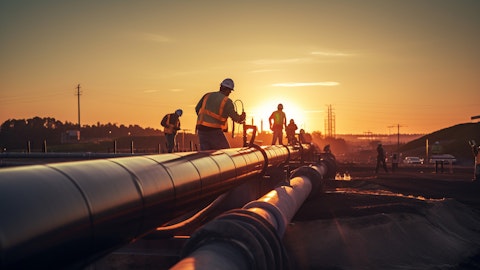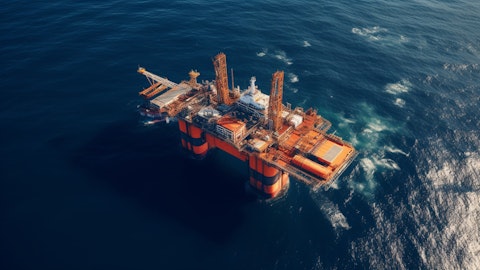Robert Catellier: Okay. And just on the assigning that capacity to a third party. I’m just curious if you see any benefit in waiting until closer to the commercial operating date in an effort to maximize value once the project is derisked?
Stuart Taylor: We’ve — we’re looking at that, Rob. It’s one of those things that we’re looking at the timing. Nothing will take place until post-FID. We’ve been in conversations with a number of parties for a fair period of time. We’ve — we continue to have ongoing conversations. And at the end of the day, we’ll look at that timing. We think we have the opportunity to do the right deal for us. And so we’ll evaluate that timing. And if the right deal comes in for us to execute, we will move on it if it means taking a bit more time, we’ll do that as well. But we’re actively engaged in conversations with Sable and making good progress on that.
Robert Catellier: Okay. And finally, it sounds like this might have to wait till next week, but I’m curious if there’s any update on how you plan to source the supply of that thing for the transportation agreement with Dow?
Cameron Goldade: Yes, I think that’s right, Rob. I think we’ll probably punt that until next week and sort of give everyone the benefit of rolling that out.
Robert Catellier: Okay. Thank you.
Operator: Your next question comes from Ben Pham of BMO. Your line is already open.
Ben Pham: Hi, thanks. Good morning. You mentioned the NEBC project. You have Cedar LNG. It sounds like there’s something on ethane Dow as well in terms of CapEx. When you think about all those projects and maybe the other projects ahead, where do you see your annual CapEx spending the next three or four or five years? And what point do you have to truck to consider the sources of funding beyond the debt markets?
Cameron Goldade: Hey Ben, it’s Cam. I think picking up on my earlier comments, I would say that if we look forward right now and let’s play out a couple of scenarios, if we proceed and make a positive final investment decision on Cedar, we’re probably running right around cash flow after dividends in terms of capital levels for the next couple of years. And then the heavy piece of the Cedar spend starts to trail off then. If we think about longer term, I mean, obviously, that’s a little bit harder to gauge, but obviously, we continue to advance the backlog. But what I would say is we’re very conscious of not only the nature of the projects, but how they fit together as a program in terms of our strategy and also the funding piece.
So, it is certainly an important input to the capital allocation process. If we look at a scenario where we didn’t, in fact, proceed with Cedar, just to play that out for a moment. Obviously, we would have substantially more free cash flow to work with. And obviously, per my earlier comments, we look at the same alternatives that we’ve discussed already. But ultimately, we’ve got some pretty attractive opportunities in front of us. And I think provided those continue on the path they’re on. We’ll be running probably pretty close to free cash flow at those levels for the next couple of years at least.
Ben Pham: Okay. Got it. And I apologize, I may have missed this. On your facilities segment, you referenced operating expense pressure. I think that’s the very bridge. Can you unpack that a bit? And can you also comment, is there anything you’re seeing on maybe some of your producers curtailing production because of low AECO prices?
Jaret Sprott: Hey Ben. No, like we’ve said before — I’ll take the second part of your question. The majority of our assets are, if not all of our assets are pretty much in the liquids-rich window. So, we haven’t seen any curtailment. And if we have, it’s been sort material that we haven’t noticed it. Our customers have great condensate yields and great NGL yields, which, ultimately, even in a low AECO natural gas price, we’re still seeing strong volumes through PGI, et cetera. No, we’re not seeing anything in with respect to cost pressures, not seeing anything like out of the ordinary, just a little bit more work in certain areas that wasn’t totally contemplated at the time. But just your normal supply chain and inflation pressures, but nothing out of the ordinary that is keeping yourself, that’s for sure.
Cameron Goldade: And Ben, just to tag on to that. I mean, the one thing that we saw ended informed part of that variance this quarter was just — you’ll remember the union agreement that was renegotiated in the Port of Vancouver last year. That’s showing up in the variance quarter-over-quarter in Q1. It’s just a few million dollars, but it’s — that’s part of the variance.
Ben Pham: Okay. Thank you very much.
Operator: Your next question comes from Zack Van Everen of TPH & Company. Your line is already open.
Zack Van Everen: Perfect. Good morning guys. Just a question on the new pipeline you mentioned between Taylor and Gordondale. Would there be any additional infrastructure downstream needed to support that if you guys sanction that project? And then is there enough space on Peace and the fracs to accommodate the incremental liquids there?
Jaret Sprott: Good morning. Yes, so once we cross the border from Taylor to Gordondale, there’s no incremental — no material incremental like pipelining work that’s required from Gordondale into the Edmonton and/or the Fort Saskatchewan market. We will require some pump stations on certain segments of the line, and that’s primarily from Fox Creek into the market, Edmonton and Fort Saskatchewan. That has always been contemplated right way back from the time of the Phase 3 expansion to grow those volumes. And so that’s — so we’re extremely well-positioned to capture those volumes without having to deploy a whole bunch of mainline capital.





